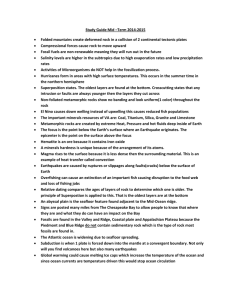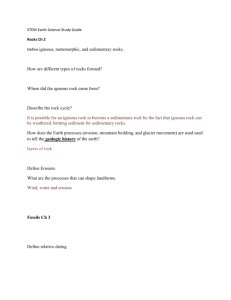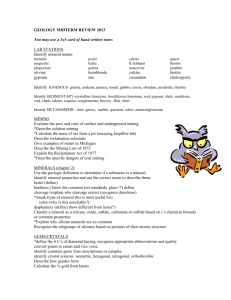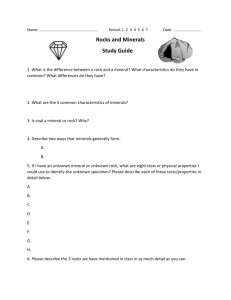Study Guide for Rocks and Minerals
advertisement
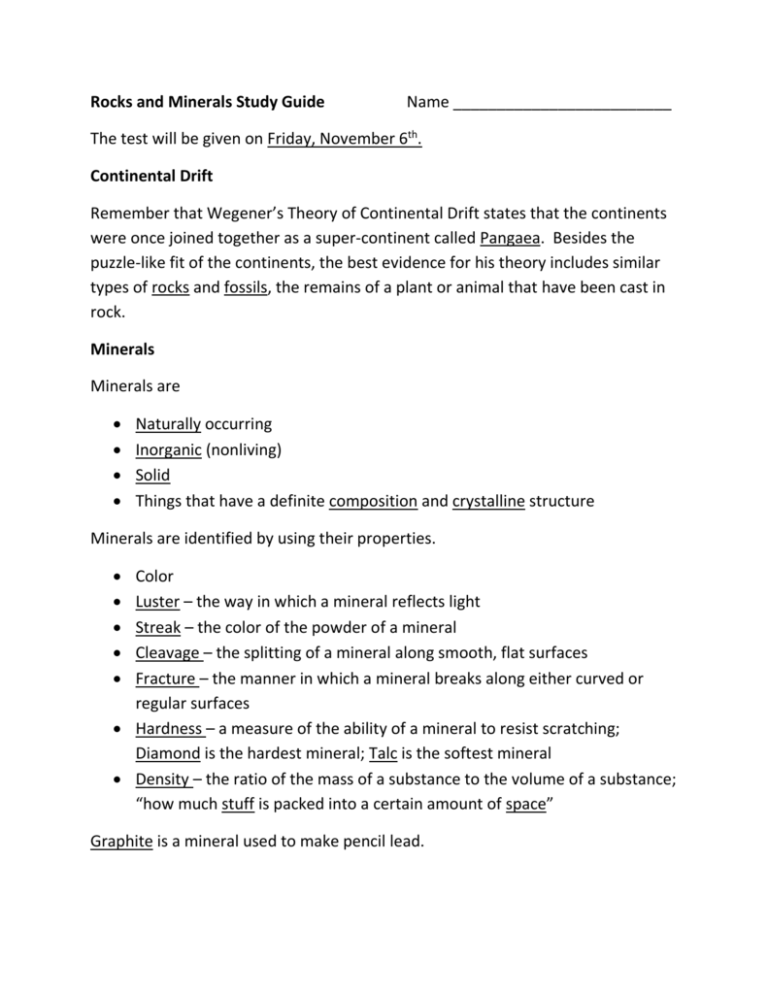
Rocks and Minerals Study Guide Name _________________________ The test will be given on Friday, November 6th. Continental Drift Remember that Wegener’s Theory of Continental Drift states that the continents were once joined together as a super-continent called Pangaea. Besides the puzzle-like fit of the continents, the best evidence for his theory includes similar types of rocks and fossils, the remains of a plant or animal that have been cast in rock. Minerals Minerals are Naturally occurring Inorganic (nonliving) Solid Things that have a definite composition and crystalline structure Minerals are identified by using their properties. Color Luster – the way in which a mineral reflects light Streak – the color of the powder of a mineral Cleavage – the splitting of a mineral along smooth, flat surfaces Fracture – the manner in which a mineral breaks along either curved or regular surfaces Hardness – a measure of the ability of a mineral to resist scratching; Diamond is the hardest mineral; Talc is the softest mineral Density – the ratio of the mass of a substance to the volume of a substance; “how much stuff is packed into a certain amount of space” Graphite is a mineral used to make pencil lead. Rocks The most useful way to identify a rock is by its mineral content. Different colors in rocks are due to the different minerals in them. Rocks are classified by how they are formed, and there are three types of rocks – sedimentary, igneous, and metamorphic. One type of rock can be changed into another by undergoing the rock cycle. When old rock is changed into new rock during the cycle, it takes a very LONG time. Not all rocks go through the entire cycle. Sedimentary Rocks Sedimentary rocks are formed by weathering (when wind, water, and ice break down rocks into sediment), erosion (when soil and sediment is moved from one place to another), and deposition (the process in which material is laid down). Layers of sediment are pressed and cemented together to form sedimentary rock. Most fossils are found in sedimentary rock. Sandstone is an example of a sedimentary rock. Igneous Rocks Igneous rock forms when hot, liquid rock, or magma, cools and solidifies. (Magma is formed underground, but it is called lava when it reaches the surface.) Volcanos are associated with igneous rocks. Intrusive igneous rock is formed beneath the Earth’s surface. Because of the slow cooling time, large crystals are formed. Extrusive igneous rock is formed on the Earth’s surface, and since it cools quickly, very small or no crystals are formed. Stone Mountain is made of Granite, an igneous rock. Metamorphic Rocks Metamorphic rocks are rocks in which the structure, texture, or composition have changed. Metamorphic rocks are formed by extreme heat and pressure. Marble is an example of a metamorphic rock. Fossils Studying fossils helps us learn how the Earth’s environment has been changed. In large sections of sedimentary rock, the oldest fossils will be found in the bottom layer. Sometimes fossils from ocean animals are found on tops of mountains! That means that the mountain was once covered by the ocean a very long time ago and the mountain was raised up due to the movement of lithospheric plates. Fossil Fuels Fossil fuels can be obtained by surface mining, strip mining (removing long strips of overlying soil and rock), and drilling wells. The energy found in fossil fuels originally came from the Sun. Petroleum and natural gas form mainly from decayed sea organisms. Smog is the photochemical base formed when sunlight acts on industrial pollutants and burning fuels.


